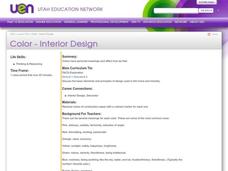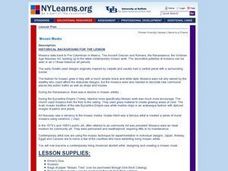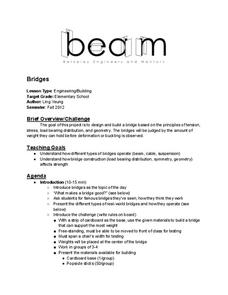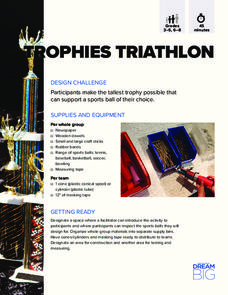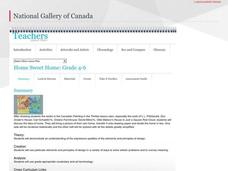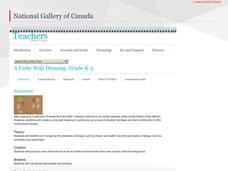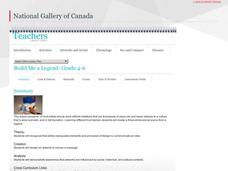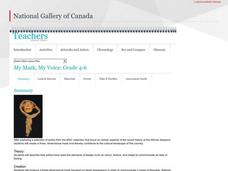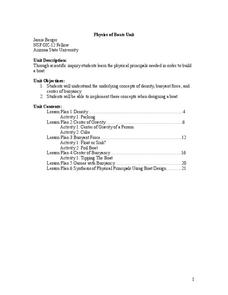Curated OER
Introduction to the Principles of Design & Balance
Students explore the relationship of the principles of design to the elements and also the principle of balance. They demonstrate knowledge of fashion strategies. Students distinguish between line, texture, color, shape/form and patterns.
Curated OER
Color - Interior Design
Young scholars review the principle elements of design along with the sequence of colors on the color wheel. In groups, they assign a feeling or mood to each color and share it with the class. To end the instructional activity, they use...
Curated OER
ARTSEDGE: Creating Costumes
Young designers examine famous monarch portraits and costume books, create a design for the emperor, examine fabric samples and choose a type and color for their costume. They sketch the costume and present it in a class fashion show.
Curated OER
What's Shaking? Three-Lesson Unit
Your young architects use the Internet to research tall structures or sky scrapers to help in the design of their scale drawings. This is lesson one of three in which learners design, build, and test model skyscrapers for seismic safety....
Curated OER
Mosaic Masks
Students discover the history of mosaics through teacher-lead lectures and discussions. Individuals spend 3-4 weeks creatively constructing mosaic masks using step-by-step design instructions.
Curated OER
Element of Texture
Pupils examine the role of texture in various fashion designs. After watching a PowerPoint presentation, they identify the different types of textures they saw in photographs. To end the lesson, they create a portfolio using their...
Berkeley Engineering and Mentors
Bridges
This engineering activity gets youngsters working together to design and construct a bridge. Each bridge is tested in front of the class to discover how much weight it can hold before showing any change in form. The lesson plan does not...
DiscoverE
Trophy Triathlon Design Challenge
Build a trophy and be a winner. Pupils build trophies that can support a sports ball of their choosing. Based on the ball choice, they figure out how the height requirement changes.
Curated OER
Flight Dreams - Folding into Flight
Combine measurement, following directions, physics, and art with one fun activity. Learners read a set of instruction to create three different kinds of paper airplanes. They measure, fold, and fly the planes, and record data and answer...
Massachusetts Department of Education
Similarity through Transformations
Create the ultimate miniature golf course. The 93-page model curriculum unit from the Massachusetts Department of Elementary and Secondary Education contains nine lessons on understanding similarity in terms of both Euclidean geometry...
National Gallery of Canada
Urban Scenes
Select a theme together to guide and inspire works of art. Class members view images of art and discuss the images of cities. After choosing a theme, individuals create posters that reflect and contribute to the theme. They can use paint...
National Gallery of Canada
Home Sweet Home
What are your pupils' homes like? Incorporate their homes into a drawing lesson plan. Using an enlarged photograph, class members draw a grid so they can easily split their drawing in half. The final product should demonstrate cool...
National Gallery of Canada
A Unity Wall Drawing
Build class community with an art project. Learners first examine and discuss works of art. They then contribute to a class mural by tracing their hands and decorating them in relation to their own cultures. The final mural...
National Gallery of Canada
One Look Is Worth A Thousand Words
Facial expressions can communicate complex emotions. Examine expressions in several hyperrealistic works of art before beginning a project. Learners will create their own clay faces that show an emotion using either photos or their own...
California Education Partners
My Five Senses by Aliki
An assessment designed to examine scholars' reading comprehension skills takes place over three days. Starting with a read-aloud of My Five Senses by Aliki, learners then take notes and discuss their most memorable moments with...
National Gallery of Canada
Social Realism
Examine social strife in art. Class members first observe some pieces, and then find an image to inspire their own art. They outline the picture, analyze the composition, make alterations, and color their work.
National Gallery of Canada
Build Me a Legend
Legends are full of imagery and action. Transfer a scene from a legend to a three-dimensional art piece. Class members first view Inuit art and discuss legends. They then build scenes that include action, setting, and characters.
National Gallery of Canada
My Upside-Down World!
M.C. Escher is famous for creating optical illusions. Examine this effect in several of his works and discuss the techniques involved. Inspired by the discussion, learners create an imaginary 3-D world inside of a box using various...
National Gallery of Canada
Panoramic Landscapes
Combine landscape with collage to create unique art pieces. Class members examine works of art before creating their own pieces with photos of a special place. Learners create a panoramic image and add in figures.
NASA
Heavy Lifting
Accept NASA's challenge to design heavy lifting vehicles. Groups of three design balloon-powered rockets to carry as much payload to the ceiling as possible. The teams are encouraged to launch several times while making...
National Gallery of Canada
Artful Emotions
Blue is sad, and red is angry, but why is that? Young artists explore the expression of emotions through art by observing and creating artwork. Starting with a questioning session about images of art, this plan moves into a sculpture...
National Gallery of Canada
My Mask, My Voice
Recognize Black History Month with an examination of the African diaspora and a hands-on mask-making project. Learners first view and discuss images of artwork before creating their own plaster masks.
Arizona State University
Physics of Boats
Let's go sailing! An instructive unit includes six lessons with multiple activities to teach scholars about density, center of gravity, buoyancy, and the Archimedes Principle. They can complete the final project of building a boat...
Balanced Assessment
Fermi Number
A fermi number is a rough estimate of a quantity that is difficult or impossible to measure. Individuals design a process for making an estimation of a given scenario. For example, they determine a plan for estimating the number of...

